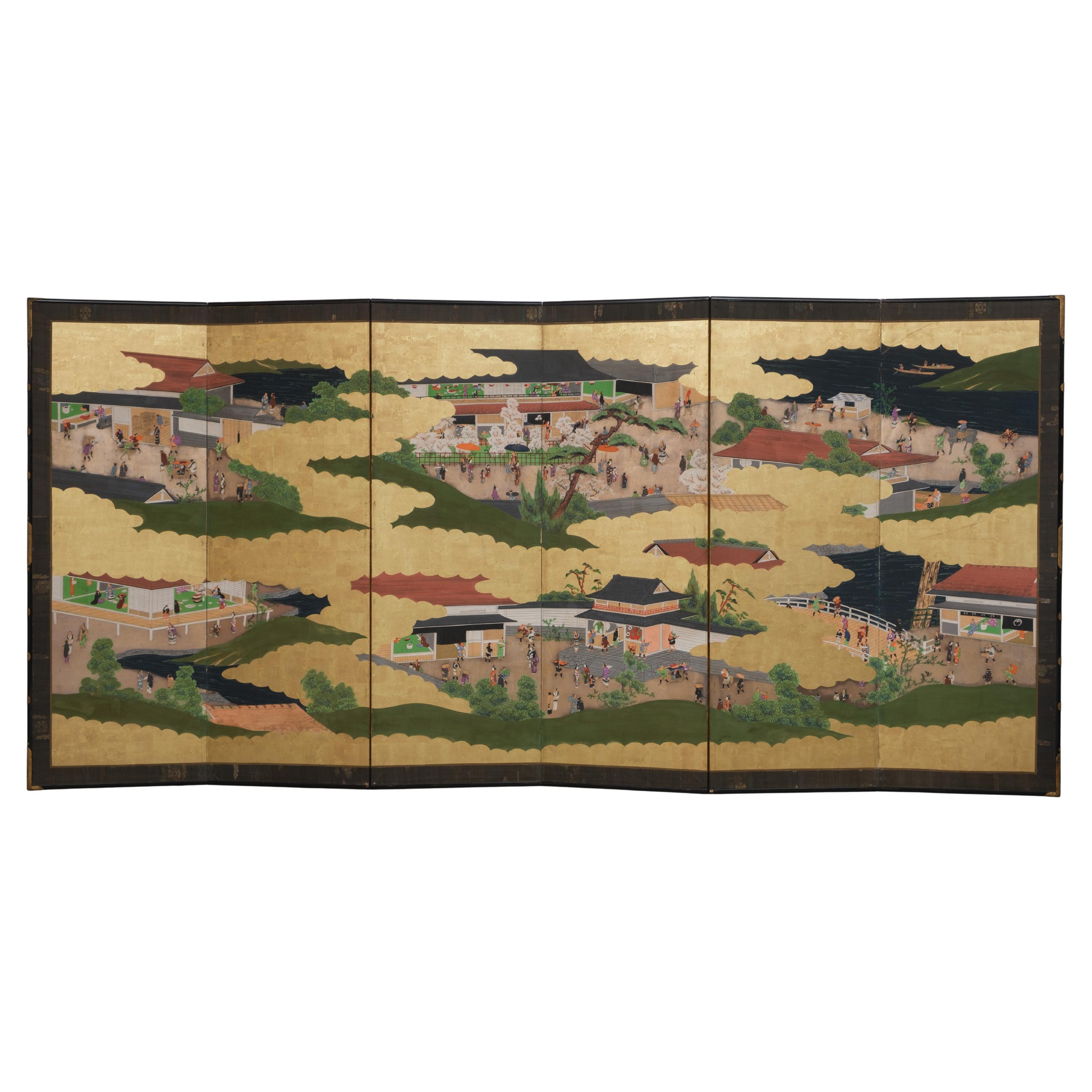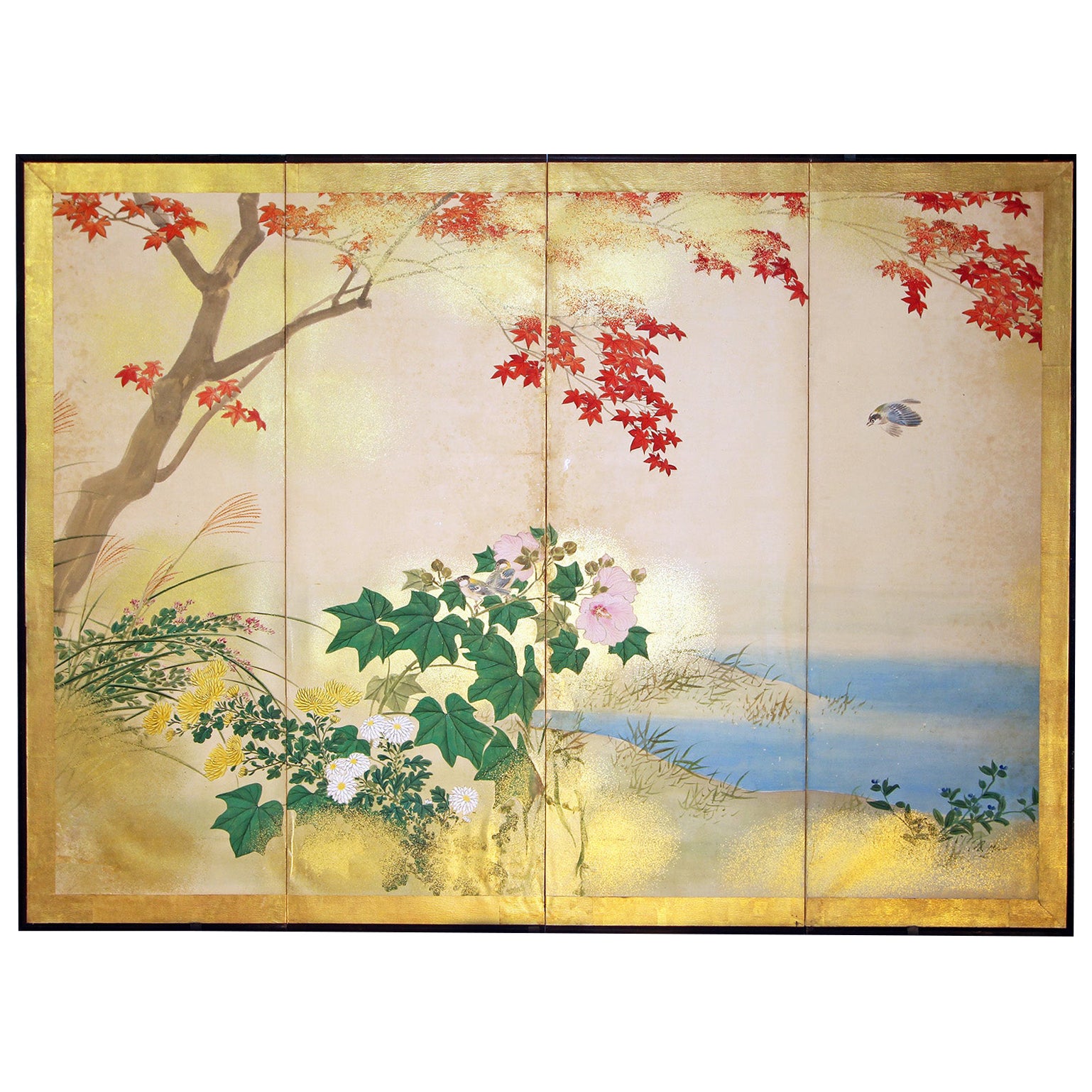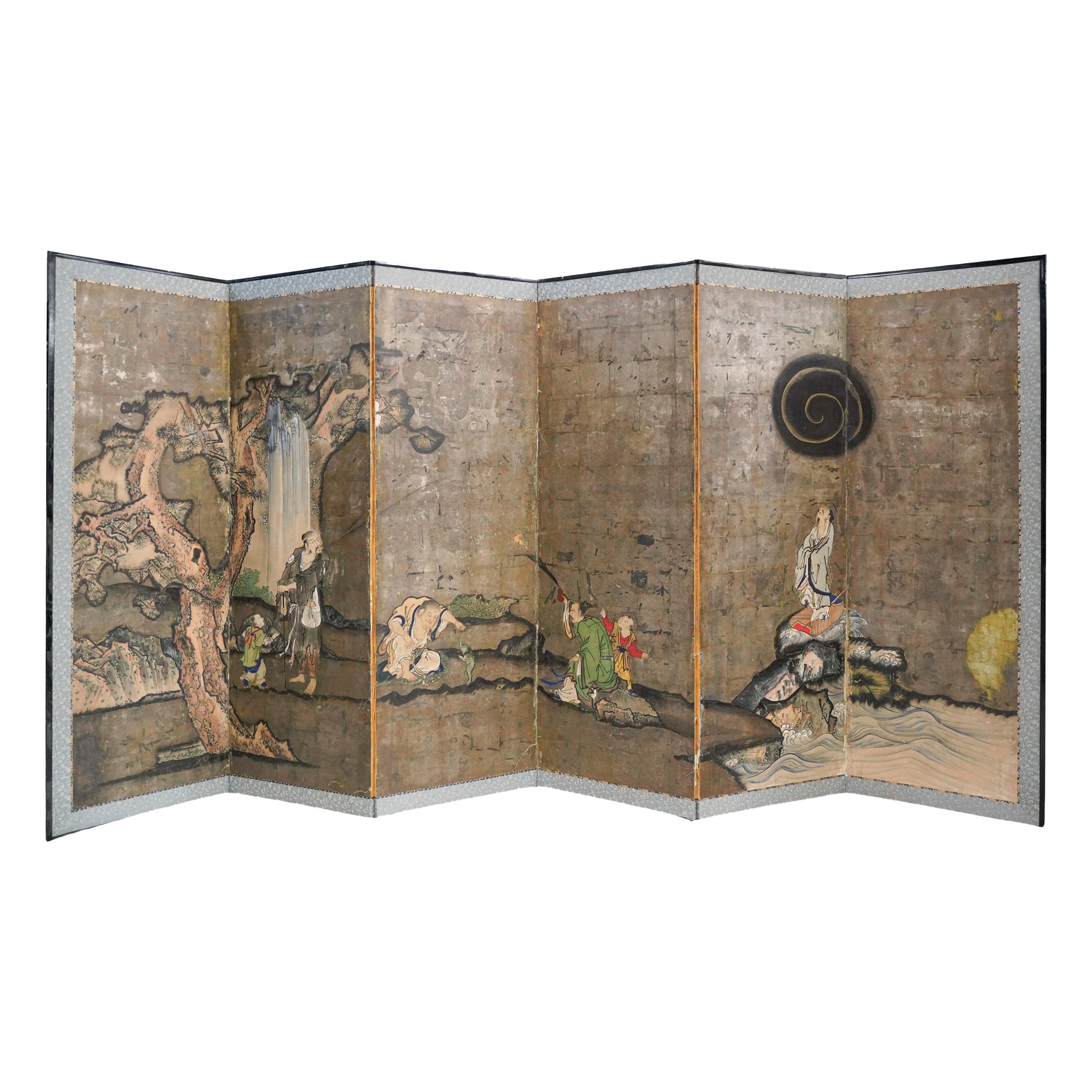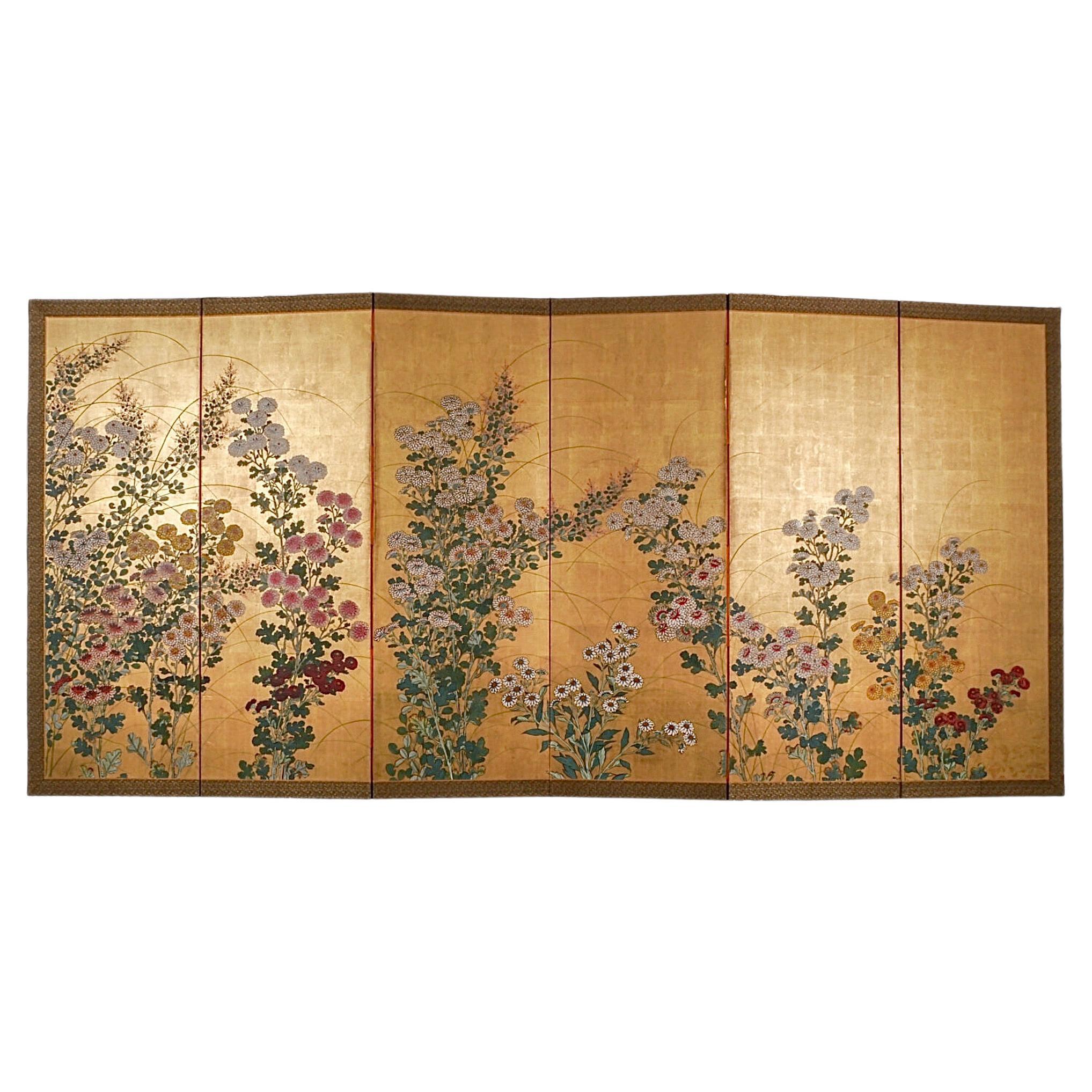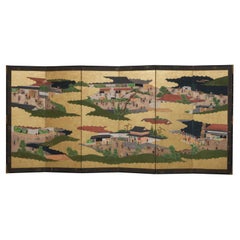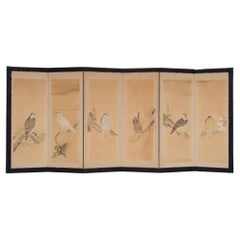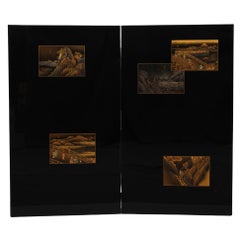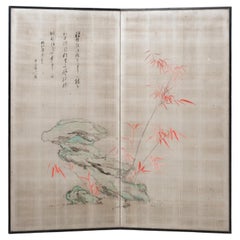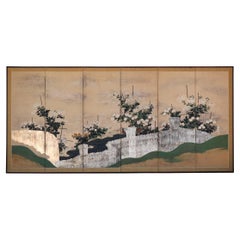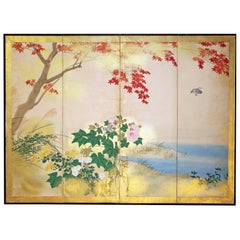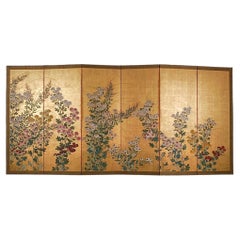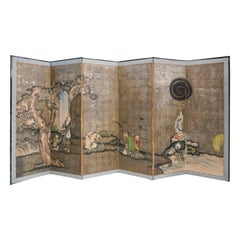Items Similar to Large Japanese 6-panel byôbu 屏風 (folding screen) with chrysanthemum garden
Want more images or videos?
Request additional images or videos from the seller
1 of 20
Large Japanese 6-panel byôbu 屏風 (folding screen) with chrysanthemum garden
About the Item
A very colourful and captivating large six-panel byôbu (folding screen) with a refined continuous painting of a luscious flower garden filled with many different types of chrysanthemums (kiku), next to a winding river.
This multi-coloured painting is set on a shiny gold-leaf background, and the chrysanthemum flowers are painted by using shell paste (gofun) in low relief.
Several clutches with a great variety of chrysanthemum flowers are in full bloom and they each show their unique form and colour. Varying from white, red, yellow and pink. The flowers bloom all around and on different kinds of bamboo fences and trellises.
In Japan chrysanthemums are believed to represent happiness, love, longevity and joy.
The panels are surrounded by two silk borders, a thin black one, and a wide brown one. The screen is protected by a black and red negoro’nuri-style lacquer wooden frame. The back of the room divider is covered with beautiful silver paper with a flower and bird pattern in low relief.
The folding screen is ideal for mounting flat on a wall and presenting as a single work of art.
Dimensions:
Total width: 144.88 in/368.0 cm (2 x 24.64 in/62.6 cm and 4 x 9.70 in/60.7 cm); Height: 68.22 in/173.3 cm.
When shipped we will add a certificate of authenticity.
Price including insured shipping.
- Dimensions:Height: 68.23 in (173.3 cm)Width: 144.89 in (368 cm)Depth: 0.6 in (1.5 cm)
- Materials and Techniques:
- Place of Origin:
- Period:
- Date of Manufacture:Early Meiji period (Second half 19th century)
- Condition:Repaired: Please see the photos for a clear condition reference. Wear consistent with age and use. Minor losses. Considering the age, which is approximately 110-150 years old, the byôbu is in a very good condition. Some small signs of age, wear and old repairs. There is some wear one the original brown silk border.
- Seller Location:Amsterdam, NL
- Reference Number:Seller: 2113241stDibs: LU7165236329462
About the Seller
4.8
Vetted Professional Seller
Every seller passes strict standards for authenticity and reliability
Established in 1996
1stDibs seller since 2022
22 sales on 1stDibs
Typical response time: 16 hours
- ShippingRetrieving quote...Shipping from: Zwanenburg, Netherlands
- Return Policy
Authenticity Guarantee
In the unlikely event there’s an issue with an item’s authenticity, contact us within 1 year for a full refund. DetailsMoney-Back Guarantee
If your item is not as described, is damaged in transit, or does not arrive, contact us within 7 days for a full refund. Details24-Hour Cancellation
You have a 24-hour grace period in which to reconsider your purchase, with no questions asked.Vetted Professional Sellers
Our world-class sellers must adhere to strict standards for service and quality, maintaining the integrity of our listings.Price-Match Guarantee
If you find that a seller listed the same item for a lower price elsewhere, we’ll match it.Trusted Global Delivery
Our best-in-class carrier network provides specialized shipping options worldwide, including custom delivery.More From This Seller
View AllLarge Japanese 6-panel byôbu 屏風 (folding screen) with Edo genre painting
Located in Amsterdam, NL
An elaborate, large six-panel byôbu (folding screen) featuring a detailed genre painting on gold leaf, capturing the vibrancy of festive scenes from the Edo period.
Central to the p...
Category
Antique Early 19th Century Japanese Paintings and Screens
Materials
Metal, Gold Leaf
Large Japanese 6-panel byôbu 屏風 (folding screen) of perched taka 鷹 (hawks)
Located in Amsterdam, NL
Wonderful large six-panel byôbu (folding screen) covered with six separate hanging scroll paintings (kakejiku) depicting different taka (hawks) perched on rocks and branches situated...
Category
Antique Early 19th Century Japanese Paintings and Screens
Materials
Silk, Wood, Lacquer, Paint, Paper
Tall, Japanese lacquer byôbu 屏風 (folding screen) by Mitsuo Takana 高名光夫 (1956)
By Mitsuo Takana
Located in Amsterdam, NL
Refined, tall two-panel byôbu (folding screen) completely adorned with ‘Wajima Ryûsaku’ lacquer by the Nitten award winning artist Mitsuo Takana (1956).
Featuring five refined images inspired by woodblock prints from the famous series ‘Tôkaidô gojûsan tsugi’ (The fifty-three stations of the Tokaido road), like the 1st station Nihonbashi, the 10th station Hakone, and the 21st station Okabe.
The design is executed in hiramaki-e (low-relief lacquer design) in shades of gold, silver, heightened by some multi-coloured details. Set on a shiny black lacquer substrate.
Signed in red lacquer in the lower right corner.
Including original signed & sealed wooden tomobako (storage box). The front with an inscription about the contents as described above. The inside:
‘Friend of the Nitten Exhibition Takana Mitsuo’ - Seal: ‘Hikari’.
‘Lacquer artist Wajima Ryûsaku’ - Seal: ‘Ryûsaku’.
Mitsuo Takana was born 1956 in Wajima, Ishikawa prefecture. He won several awards during exhibitions like: Ishikawa Contemporary Art Exhibition, Japan Artisans' Association Exhibition and the well-known Nitten Exhibition.
Dimensions:
Height 57.48 in/146 cm, Total width 66.92 in/170 cm (2 x 33.46 in/85 cm), Depth 1.10 in/2.8 cm.
Weight 56.21 lb/25.5 kg.
Wajima lacquerware...
Category
Late 20th Century Japanese Paintings and Screens
Materials
Wood, Giltwood, Lacquer
Large Japanese 2-Panel Byôbu 屏風 'Room Divider' with Painting of Bamboo & a Poem
Located in Amsterdam, NL
Beautiful, large two-panel byôbu (room divider) with a serene painting of red-leaved bamboo and rocks on an oxidized silver leaf background. Silver leaf continuously undergoes the process of oxidation, which creates a beautiful aged patina.
On the left an inscription from a ‘Zekku’ poem by the Chinese poet Yang Zai (1271?1323), titled: Shan shang zhu (bamboo (painted) on a fan).
Translated as :
Why would people plant a lot of bamboos?
The shade of a single culm is also beautiful.
In the autumn night it rocks on the wind,
And the fresh sound echoes in my dream.
Dated: Shôwa, the year kôshin (1938). Signature unknown...
Category
Early 20th Century Japanese Paintings and Screens
Materials
Other, Silver Leaf
Pair of Japanese kakejiku 掛け軸 (hanging scrolls) depicting Niô guardians 仁王
Located in Amsterdam, NL
Pair of impressive, antique kakejiku (hanging scrolls) showcasing the awe-inspiring Niô guardians, also referred to as heavenly kings.
Each painting cap...
Category
Antique Early 18th Century Japanese Paintings and Screens
Materials
Brocade, Silk, Paint
$16,251 / set
Free Shipping
Rare set of 2 Japanese suits-of-armour, complete with 2 matching folding screens
Located in Amsterdam, NL
Important unique set of two suits-of-armour (yoroi), complete with two high six-panel screens, that belong together as is indicated by the used family crests (mon). Two crests are used, both belonging to the Nakagawa family of Oka Castle, Ôita prefecture on Kyûshû.
They are:
– the Nakagawa-kurusu, a circle depicting a Celtic-like cross through a ring.
The cross was originally a Christian symbol but after the ban on Christianity in Japan the use of a hidden cross in family crests could continue.
– the Nakagawa-kashiwa, two leaves of the Japanese Emperor Oak turned to each other (dakikashiwa mon).
The remarkable aspect of this ensemble is the presence of matching crests on both the yoroi and the accompanying folding screens. The kurusu and kashiwa crests adorning the yoroi are elegantly replicated on the screens, providing compelling evidence that these pieces form a harmonious and unified set. This exceptional cohesion between the armour and screens further enhances their artistic and historical value.
After the warlord Toyotomi Hideyoshi (1537-1598) had interfered in the battle between the Lord of Bungo Province Ôtomo Yoshi-mune (1558-1605) and the Shimazu of Hyûga Province, he split the Bungo Province in a number of small fiefs and transferred in 1594 Nakagawa Hideshige (1570-1612) from Miki Castle
in the Harima Fief to Oka Castle in Kyûshû.
The Nakagawa family stayed in possession of Oka Castle till the abolishment of the military use of castles in 1873. In 1884 the Nakagawa family received the title of Count (a title in use till the abolishment of aristocracy in 1947).
After the Nakagawa’s left, the castle and the building soon dilapidated and is now known as Oka Castle Ruins. The castle is located in Taketa Village part of Taketa Town in Ôita Province on Kyûshû.
> Set of two tall byôbu (folding screens),
painted with large red jinmaku (camp enclosure curtain) on a gold leaf ground. The curtains show both crests of the Nakagawa family: one screen depicts two Nakagawa-kurusu crests next to a Nakagawa-kashi crest in the middle, and the other shows the symbols the other way round.
Dimensions:
Total width 148.66 in/377.6 cm (2 x 25.35 in/64.4 cm, 4 x 24.48 in/62.2 cm); Height 72.63 in/184.5 cm.
Period: Japan – Late Edo period (First half 19th century), and maybe even older.
> Yoroi with Nakagawa-kashiwa crest:
A Japanese black lacquered suit-of-armour (yoroi) completely laced with orange cords (kuro’urushinuri hi’ito odoshi nimai’dô’maru).
A thirty-two plate suji’bachi kabuto (helmet with raised ridges) with in front a maedate (fore crest) -with traces of gilding- in the shape of flames, resembling a mythical flaming bird flying down. The fukikaeshi (face guards) and the mabizashi (visor) have the Nakagawa-kashiwa crest in gold maki-e lacquer.
Five curved ‘itazane’-plate neck guards (shikoro) laced with orange cords.
Together with an ‘angry man...
Category
Antique 18th Century Japanese Antiquities
Materials
Metal, Iron, Gold Leaf
You May Also Like
“Kiku Byobu”, a six-panel chrysanthemum folding screen, Rinpa School
Located in Point Richmond, CA
“Kiku Byobu”, a six-panel chrysanthemum folding screen, Rinpa School, Meiji Period (1869-1912).
Painted with several variations of white moriage chrysanthemums interspersed with sma...
Category
Antique Late 19th Century Japanese Meiji Paintings and Screens
Materials
Paper
Byobu - Japanese Folding Screen
By Japanese Studio
Located in Brescia, IT
Nice four-panel Japanese screen painted on vegetal paper, depicting a landscape with a red maple, flowers and birds.
The size is very refined and easy to place in a design project.
Category
Mid-20th Century Japanese Showa Paintings and Screens
Materials
Paper
Japanese Six-Panel Screen Byobu With Chrysanthemums And Autumn Grass and Flower
Located in Torino, IT
The 19th Century Six-Panel Japanese folding screen "Byōbu" usually used in the most important Japanese house to stop wind and also to separate different space of the same big room de...
Category
Antique Mid-19th Century Japanese Edo Paintings and Screens
Materials
Gold Leaf
Japanese Chinese Asian Large Six-Panel Folding Byobu Screen Mythical Landscape
Located in Studio City, CA
A gorgeous, strangely beautiful, unusually engaging, and alluring hand-painted large six-panel Japanese/Asian Byobu folding screen depicting an almost magical/ mythical nature scene ...
Category
Antique 18th Century Japanese Edo Paintings and Screens
Materials
Gold Leaf
Japanese Byobu - Six Panel Japanese Screen
By Japanese Studio
Located in Brescia, IT
This 18th century "Kano school" six-panel screen is truly special. The author is unknown, but his singular genius in portraying these cranes near the water creates an emotion that ca...
Category
Antique Late 18th Century Japanese Edo Paintings and Screens
Materials
Paper
Antique Japanese Taisho Period Byobu Four Panel Folding Screen
Located in New York, NY
Antique Byobu Four Panel Screen.
Japan, late 19th to early 20th century. Taisho period.
Category
Antique Late 19th Century Japanese Paintings and Screens
Materials
Paper
Recently Viewed
View AllMore Ways To Browse
Wooden Screens
Antique Chrysanthemum
Wood Folding Panel
Antique Fence
Painted Folding Screen
Antique Folding Screen
Chrysanthemum Pattern
Antique Wall Screens
Foldable Dividing Screen
Divider Black Screen
Japanese Wall Panels
Folding Screens Black
Large Gold Wall Panel
Two Panel Room Divider
Wooden Screen Panels
2 Panel Screen
4 Panel Lacquered
Lacquer Folding Screens
